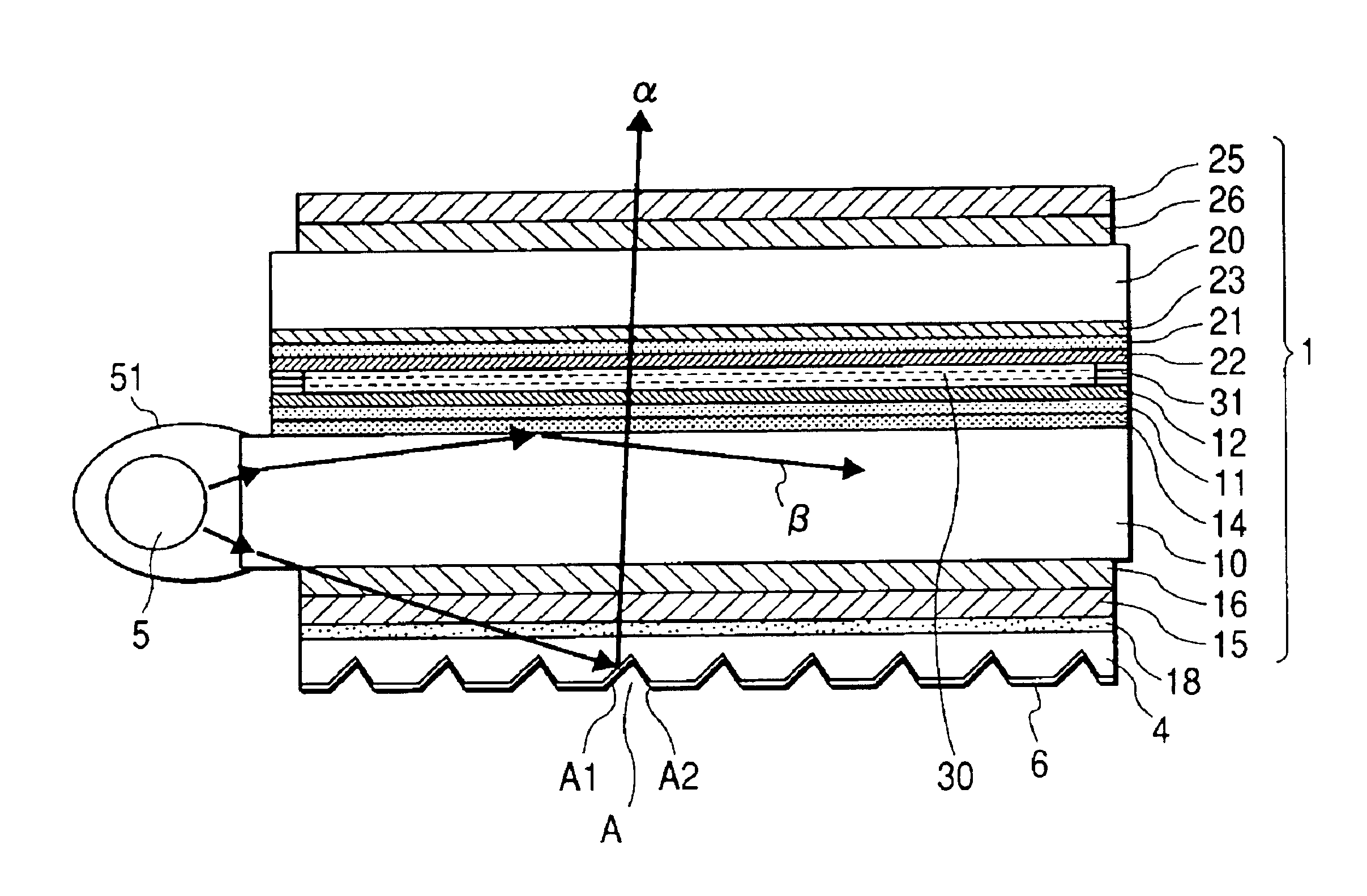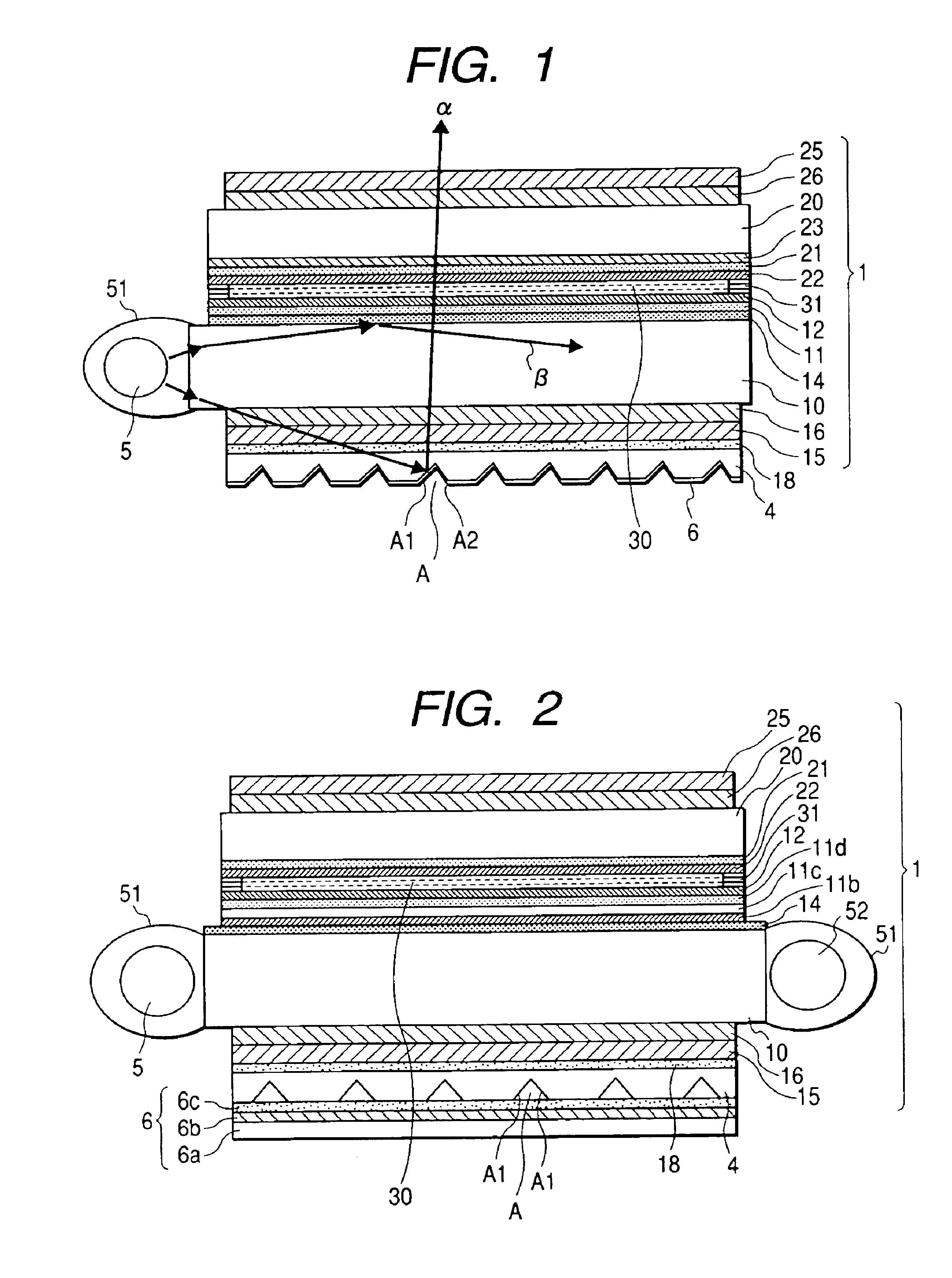Liquid-crystal display device
a display device and liquid crystal technology, applied in non-linear optics, instruments, optics, etc., can solve the problems of reducing the thickness and weight of the device as a whole, remarkably reducing the incidence of light on the side surface of the panel, and achieving excellent brightness
- Summary
- Abstract
- Description
- Claims
- Application Information
AI Technical Summary
Benefits of technology
Problems solved by technology
Method used
Image
Examples
reference example 1
[0131]Magnesium fluoride vapor was vacuum-deposited on a non-alkali glass plate having a thickness of 0.7 mm and a refractive index of 1.52 to thereby form a low-refractive-index transparent layer having a thickness of 600 nm and a refractive index of 1.38. A resin layer of a surface fine roughness structure was provided on the low-refractive-index transparent layer. Then, aluminum vapor was vacuum-deposited on the resin layer, and 250 μm-square openings were formed by an etching method so as to be distributed evenly with a numerical aperture of 20%. Thus, a half-transmission reflecting layer was provided to serve also as an electrode. The half-transmission reflecting layer was spin-coated with a polyvinyl alcohol solution and the dried film of the polyvinyl alcohol solution was subjected to a rubbing treatment to thereby obtain a back side substrate. On the other hand, an ITO transparent electrically conductive layer was formed on a non-alkali glass plate provided in the same manne...
reference example 2
[0133]A normally white liquid-crystal panel having cold-cathode tubes held on opposite side surfaces was obtained in the same manner as in Reference Example 1 except that the low-refractive-index transparent layer of magnesium fluoride was not provided on the back side substrate.
reference example 3
[0134]An acrylic-based ultraviolet-curable resin (ARONIX UV-3701 made by TOAGOSEI CO., LTD.) was dropped by a dropper into a mold processed into a predetermined shape in advance so that the mold was filled with the acrylic-based ultraviolet-curable resin. A 60 μm-thick polycarbonate (PC) film was quietly placed on the acrylic-based ultraviolet-curable resin and then stuck closely thereto by a rubber roller so that a surplus of the resin and air bubbles were removed. Then, the acrylic-based ultraviolet-curable resin was irradiated with ultraviolet rays by a metal halide lamp so that the resin was cured. Then, the resin with the PC film was released from the mold and cut into a predetermined size. The PC film was released from the resin. Thus, an optical path control layer (transparent sheet) having a refractive index of 1.51 was obtained. An acrylic-based pressure sensitive adhesive layer having a refractive index of 1.51 was attached to a surface of the transparent sheet where the o...
PUM
| Property | Measurement | Unit |
|---|---|---|
| inclination angle | aaaaa | aaaaa |
| refractive index | aaaaa | aaaaa |
| thickness | aaaaa | aaaaa |
Abstract
Description
Claims
Application Information
 Login to View More
Login to View More - R&D
- Intellectual Property
- Life Sciences
- Materials
- Tech Scout
- Unparalleled Data Quality
- Higher Quality Content
- 60% Fewer Hallucinations
Browse by: Latest US Patents, China's latest patents, Technical Efficacy Thesaurus, Application Domain, Technology Topic, Popular Technical Reports.
© 2025 PatSnap. All rights reserved.Legal|Privacy policy|Modern Slavery Act Transparency Statement|Sitemap|About US| Contact US: help@patsnap.com



